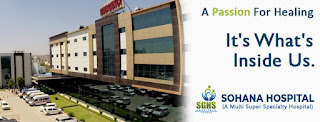Causes, symptoms and treatment options for varicose veins?
Varicose veins are a very common condition with the leg's veins becoming swollen and twisted, sometimes accompanied by discomfort, pain, and serious health complications. Let us delve into what varicose veins are, what causes them, and what symptoms, and in discussion go through some of the advanced treatment options, best treatment for varicose veins available at Sohana Hospital, latest advancement like Venaseal technique.
What Are Varicose Veins?
Varicose veins are twisted, swollen veins which characteristically appear blue or dark purple and are mostly found in the legs. As pressure inside these veins increases the blood inside these veins starts bulging those valves which are not functioning properly. Major symptoms of this disorder are aches, heaviness, or discomfort in the legs and may lead to even more critical problems. Common causes of their development are genetics, growing age, pregnancy, obesity, and prolonged standing.
The treatment for varicose veins involves a few lifestyle changes but a few medical procedures are also available like sclerotherapy, laser treatment and Venaseal which is one of the new advancements and a less invasive procedure.
In Venaseal a medication is used to shut down the infected vein. A catheter is inserted into the veins and the vein is sealed off, resulting in the recovery and ending discomfort much more precisely than the other given methods.
Causes of Varicose Veins
However, the primary cause of varicose veins has to do with how veins function. When these valves collapse the blood collects within the veins, and thus causes swelling and the characteristic bulging appearance of varicose veins.
Factors responsible for development of varicose veins:
1. Genetics: A history of family cases is a risk factor that makes a person more prone towards varicose veins.
2. Age: Veins become inelastic with age.
3. Gender: Women are more vulnerable due to the effect of hormonal changes.
4. Sedentary Lifestyle: Sitting or Standing for long hours may reduce the flow of blood.
Symptoms of Varicose Veins
Although most people with this condition rarely experience complications, symptoms can include swelling, mostly in the legs and ankles; aching or pain that worsens when standing or sitting for long periods; feeling of heaviness in the legs; itching around the affected veins; and discoloration or ulcers overlying itchy skin, as cases can be extreme.
If you notice any of these symptoms, see a professional for proper evaluation and treatment.
Treatment Options at Sohana Hospital
Some treatment options are available to patients diagnosed with varicose veins at Sohana Hospital. These are selected from the list of treatments above, according to the condition's complexity and your current health condition. The most common ones are highlighted, keeping in mind Venaseal treatment.
1. Venaseal Technique
Venaseal is one of the latest technologies when it comes to treating varicose veins. It uses an adhesive medication to close the affected veins. This procedure is minimally invasive, so there is no need for anesthesia or large incisions.
Benefits of Venaseal technique:
Quick Recovery: The patients can resume their normal activities almost immediately after the treatment.
Less Pain: A lot of patients say that they experienced less pain and swelling after this treatment compared to traditional treatment methods.
Requires fewer compression stockings: Venaseal is something that does not normally require using compression stockings for a period of time as compared to other treatments.
Venaseal: It is very effective and convenient
2. Sclerotherapy
Sclerotherapy is a procedure in which a solution is injected in veins, causing them to close and fade away. This is specially made for small and spider veins. Though less invasive, sclerotherapy requires more than one session to achieve proper results and does come with some discomfort.
3. Radiofrequency Ablation
In this treatment the veins are heated up and dissolved using radiofrequency energy. A catheter is placed inside the vein, which causes the vein wall to seal shut by heating it. Even though this treatment is highly effective, it is sometimes uncomfortable and requires local anesthesia in most cases.
4. Surgical Options
More advanced conditions can be more invasive and require surgical intervention. Other options include vein stripping or ligation, which often involve a more aggressive treatment and longer recovery times.
Conclusion
Varicose veins are a relatively common yet treatable condition that might interfere in your quality of life. Knowing the causes, symptoms, and the options available at Sohana Hospital is going to be crucial for the proper management of the condition.
Venaseal is one of the most convenient, quick, and painless treatments and endoscopic methods of managing varicose veins. If you notice symptoms on varicose veins then you should not hesitate to seek medical help. The earlier the treatment starts, the more effective the results will be in helping you lead an active and pain-free life. If you are someone looking for the ‘best treatment for varicose veins’ or ‘varicose vein center near me’ or visit Sohana Hospital today and learn more about the latest treatment options.




Comments
Post a Comment